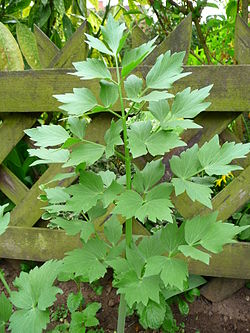Lovage
| Lovage | |
|---|---|

| |
| Scientific classification | |
| Kingdom: | Plantae |
| Clade: | Tracheophytes |
| Clade: | Angiosperms |
| Clade: | Eudicots |
| Clade: | Asterids |
| Order: | Apiales |
| Family: | Apiaceae |
| Subfamily: | Apioideae
|
| Genus: | Levisticum Hill
|
| Species: | L. officinale
|
| Binomial name | |
| Levisticum officinale | |
Lovage (
Description

Lovage is an erect, herbaceous, perennial plant growing to 1.8–2.5 m (6–8 ft) tall, with a basal rosette of
Taxonomy
Etymology

The name "lovage" is from "love-ache", ache being a medieval name for
Distribution
Levisticum officinale is native to Afghanistan and Iran,[7] but has been introduced to most of Europe, and parts of Southeast Asia, North and South America.[7] It has been long cultivated in Europe, the leaves being used as a herb, the roots as a vegetable, and the seeds as a spice, especially in southern European cuisine.[8]
Health concerns
Lovage root contains
Uses
The leaves can be used in salads, or to make soup or season broths, and the roots can be eaten as a vegetable or grated for use in salads. Its flavour and smell are reminiscent both of celery and parsley, only more intense and spicy than either. The seeds can be used as a spice in the same way as fennel seeds.[8]
- In the ]
- In Ukraine, lovage (in Ukrainian любисток/liubystok) is considered an aphrodisiac. Traditionally, an infusion prepared from lovage leaves has been used by women for rinsing their hair, in order to attract men with the pleasant spicy smell of the plant. Nowadays, hair conditioners can be bought which contain lovage extract to strengthen the hair. Lovage leaves and roots are also used in salads and as a spice in Ukraine.
- In Romania, the leaves are a preferred seasoning for the various local broths and are just as popular, in this respect, as parsley or dill.[12] Furthermore, the dried foliage and seeds are added to pickled cabbage and cucumbers both to aid in their preservation and to add flavour to them.[13]
- In the
The roots, which contain a heavy volatile oil, are used as a mild aquaretic.[15]
In culture
A recommendation to cultivate lovage on the agricultural properties of Charlemagne appears in chapter 70 of Capitulare de villis, a text written around 800 AD about the maintenance of royal estates.[a][16]
Notes
- ^ De villis vel curtis imperialibus (Of imperial lands and imperial courts). Volumus quod in horto omnes herbas habeant, id est (We want that in the garden they have all sorts of plants, that is): Lilium (lily), Rosas (roses), Fenigrecum (fenugreek or methi), Costum (costmary), Salviam (sage), Rutam (rue), Abrotanum (southernwood), Cucumeres (cucumbers), Pepones (big melons), Cucurbitas (European gourd), Fasiolum (bean, here black-eyed pea), Ciminum (cumin), Rosmarinum (rosemary), Careium (caraway), Cicerum italicum (chickpea), Squillum (squill), Gladiolum (gladiolus), Dragantea (dragon arum), Anesum (aniseed), Coloquentidas (colocynth), Solsequiam (heliotrope), Ameum (meum athamanticum), Silum (seseli), Lactucas (lettuces), Git (black cumin, nigella), Eruca alba (aragula or rocket salad), Nastursium (garden cress), Parduna (burdock), Peledium (pennyroyal), Olisatum (alexanders), Petresilinum (parsley), Apium (celery), Levisticum (lovage), Savinam (savin juniper), Anetum (dill), Fenicolum (fennel), Intubas (chicory), Diptamnum (dittany of Crete or hop marjoram), Sinape (mustard), Satureium (savory), Sisimbrium (water mint), Mentam (corn mint), Mentastrum (apple mint), Tanazitam (tansy), Neptam népite (catmint), Febrefugiam (common centaury), Papaver (poppy), Betas (Swiss chard), Vulgigina (European wild ginger), Mismalvas (marshmallows), Malvas (lavateras), Carvitas (carrots), Pastenacas (parsnips), Adripias (garden orache), Blidas (purple amaranth), Ravacaulos (kohlrabi), Uniones (onions), Britlas (perennial garlic), Porros (leeks), Radices (turnips or radishes), Ascalonicas (shallots), Cepas (Welsh onions), Alia (garlic), Warentiam (madder), Cardones (fuller's teasel), Fabas majores (broad beans), Pisos mauriscos (green peas), Coriandrum (coriander), Cerfolium (chervil), Lacteridas (caper spurge), Sclareiam (clary sage)
References
- ISBN 0-947643-58-3.
- doi:10.1017/s0960428601000658.)
{{cite journal}}: CS1 maint: multiple names: authors list (link - ^ Interactive Flora of NW Europe: Levisticum officinale (Lovage)
- ^ Linnaeus, Carl (1753). Species Plantarum: exhibentes plantas rite cognitas, ad genera relatas, cum differentiis specificis, nominibus trivialibus, synonymis selectis, locis natalibus, secundum systema sexuale digestas. Vol. 1. Stockholm: Impensis Laurentii Salvii. p. 250. Archived from the original on 21 August 2020. Retrieved 6 September 2024. see also Species Plantarum
- ^ W.D.J. Koch. "Levisticum officinale". Tropicos.org Missouri Botanical Garden. Retrieved 2024-09-06.
- ^ a b "lovage". Oxford English Dictionary (Online ed.). Oxford University Press. (Subscription or participating institution membership required.)
- ^ a b "Levisticum officinale W.D.J.Koch". Plants of the World Online. Royal Botanic Gardens, Kew. Retrieved 17 March 2023.
- ^ ISBN 0-333-47494-5.
- S2CID 30154586.
- ^ Thyra (2017-06-30). "Thyra: Lovage/Løvstikke". Thyra. Retrieved 2020-09-30.
- ^ "Blogwatching: white asparagus – A Dutch ritual". DutchNews.nl. 15 June 2020. Retrieved 2020-09-30.
- ^ "În ce fel de ciorbe este indicat să folosim leuşteanul. Cât de multe frunze puternic aromate putem pune". adevarul.ro. 23 February 2017. Retrieved 2019-03-17.
- ^ "Cum faci cele mai gustoase murături". Adevarul newspaper. 13 September 2018. Retrieved 17 March 2019.
- ^ Information on Lovage Cordial Archived 2011-10-06 at the Wayback Machine
- ^ "Community herbal monograph on Levisticum officinale Koch, radix" (PDF). European Medicines Agency. 2012-03-27. Archived from the original (PDF) on 2016-06-25. Retrieved 2015-07-28.
- ^ Moncorgé, Marie Josèphe. "Of imperial lands and imperial courts Capitulary of Charlemagne". www.oldcook.com. Retrieved 6 September 2024.
External links
 Media related to Levisticum officinale at Wikimedia Commons
Media related to Levisticum officinale at Wikimedia Commons
